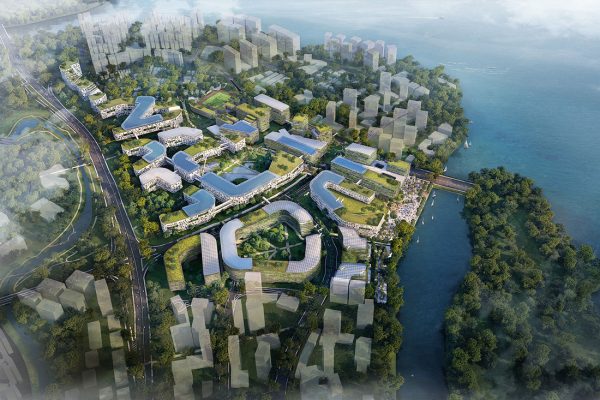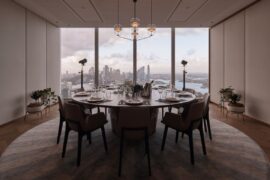We take a look at what’s in the pipeline (and the cables) for the WOHA-master-planned Punggol Digital District, where the digital economy is expected to grow and flourish.

The JTC Business Park will house key growth sectors from the cyber security and digital technology industries.
March 16th, 2018
Competitiveness, the digital economy, and urban design – it’s encouraging to see these three concepts being discussed in the same breath. Earlier this year, the Infocomm Media Development Authority (IMDA), JTC, Singapore Institute of Technology (SIT) and the Urban Redevelopment Authority (URA) unveiled the master plan for Punggol Digital District (PDD). The district is envisioned as a home for the growth industries of the digital economy, as well as a place for sustainable living and community inclusivity.
The PDD is part of Singapore’s strategy for using key development areas to bring ‘good jobs’ and social amenities closer to residents, and the URA refers to PDD as the first ‘Enterprise District’ integrating business and education, driven by technological, social and urban innovation.
“Our plan is to capitalise on future trends and the key assets in each area to develop highly integrated and inclusive spaces to live, work, play and learn,” says the URA’s CEO Lim Eng Hwee.
Says JTC’s Chief Executive Officer Ng Lang, “To be developed progressively, Punggol Digital District will be the first district to adopt a one integrated master plan approach that brings together a business park, a university and community facilities. Such a district-level planning approach creates synergies, optimises land use and catalyses community building. It also allows us to design and integrate technological and innovative platforms and services right from the start and from the ground up, potentially transforming the way we work, live, learn and play in an inclusive and sustainable district.”

An aerial view of the proposed 50-hectare Punggol Digital District.
The SIT and JTC engaged WOHA to design the master plan. The firm is also the architect for several land parcels at PDD. The overall vision for the district is for a car-light, green and vibrant environment with a good land-use mix, a cohesive scale, and seamless integration with the surrounding residential areas.
JTC’s business park will house key growth sectors for the digital economy such as cyber security, data analytics and IoT – sectors that the IMDA expects will power the digitalisation of Singapore’s economy. The business park buildings will be co-located with SIT’s new campus, with the exchange of space hoped to create greater synergy between academia and businesses for testbedding and prototyping.
JTC will curate the tenant mix in line with the demands of a digital economy; SIT’s strengths include cyber security, electrical power engineering, R&D for food technology, design, assistive technology and hospitality, so we might expect to see affiliated enterprises being set up in the business park.
SIT also hopes to create a maker space for the community, where district residents may tinker and prototype solutions to issues within their homes and environment.
At a district level, a variety of technologically inclined infrastructure systems and services will be integrated. An integrated facilities management system will centralise building services operations, allowing remote monitoring, optimisation and control of building systems. IoT systems will be incorporated from the ground up; in line with its work on the Smart Nation Sensor Platform, GovTech identifies the potential for environmental sensors to monitor air quality and noise, and cameras to detect, classify and count personal mobility devices in public spaces.
Also on the agenda are a pneumatic waste conveyance system, a district cooling system, rooftop solar power systems, and a centralised logistics hub with robot or AV pick-up and delivery of goods in the district.
Images courtesy of JTC.
A searchable and comprehensive guide for specifying leading products and their suppliers
Keep up to date with the latest and greatest from our industry BFF's!

Within the intimate confines of compact living, where space is at a premium, efficiency is critical and dining out often trumps home cooking, Gaggenau’s 400 Series Culinary Drawer proves that limited space can, in fact, unlock unlimited culinary possibilities.

Elevate any space with statement lighting to illuminate and inspire.

Vert, an innovative demountable pergola designed for urban greening, is reshaping the way we think about sustainability in urban architecture.

In this candid interview, the culinary mastermind behind Singapore’s Nouri and Appetite talks about food as an act of human connection that transcends borders and accolades, the crucial role of technology in preserving its unifying power, and finding a kindred spirit in Gaggenau’s reverence for tradition and relentless pursuit of innovation.

A new hotel conceived by revered Singaporean architecture and design practice WOHA is just the place to stay when visiting the Lion City.

Leanne Amodeo sets out to find places that nurture our enthusiasm for lifelong learning with facilities designed to feed the mind and the soul. She tours us through the quietly powerful learning spaces of The Hedberg in Hobart, and POMT’s workplace in Sydney.
The internet never sleeps! Here's the stuff you might have missed

In a prestigious design competition for a site in Kharkiv, Ukraine, Jansen Che has been announced as one of three winners at the competition stage.

Hammond Studio’s fit-out for an exclusive North Sydney workplace draws on Italy for inspiration to craft a modern and sophisticated executive office.